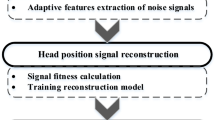Abstract
The wireless equipment acoustic signal compressed sampling has advantages of using less hardware and being robust in the noisy environment. But the major challenges of the wireless acoustic signal compressed sampling are their property of the real time sampling and their constraint of the limited communication resource. The paper designs a new robust compressed sensing arithmetic HSR which uses the hard threshold value to sample interruptly and uses the feature parameters of signal to recover signal. This method is easy to realize, Meanwhile simulation results show that HRS arithmetic is effective and robust.






Similar content being viewed by others
References
Griffin, A., Hirvonen, T., Tzagkarakis, C., Mouchtaris, A., & Tsakalides, P. (2011). Single-channel and multi-channel sinusoidal audio coding using compressed sensing. IEEE Transactions on Audio, Speech, and Language Processing, 19(5), 1382–1395.
Giacobello, D., Christensen, M. G., Murthi, M. N., Jensen, S. H., & Moonen, M. (2010). Retrieving sparse patterns using a compressed sensing framework: Applications to speech coding based on sparse linear prediction. IEEE Signal Processing Letters, 17(1), 103–106.
Giacobello, D., Christensen, M. G., Dahl, J., & Moonen, M. (2008). Sparse linear predictors for speech processing. In Proceedings of the international conference on spoken language processing.
Giacobello, D., Van Waterschoot, T., Christensen, M. G., & Jensen, S. H. (2010). High-order sparse linear predictors for audio processing. In Signal Processing Conference, 2010, European, pp. 234–238.
Giacobello, D., Christensen, M. G., Murthi, M. N., Jensen, S. H., & Moonen, M. (2012). Retrieving sparse patterns using a compressed sensing framework: Applications to speech coding based on sparse linear prediction. IEEE Transactions on Audio, Speech, and Language Processing, 20(5), 1644–1657.
Hassam, M. K., & Maha, E. S. (2014). A comparative study of audio compression based on compressed sensing and sparse fast fourier transform (SFFT): Performance and challenges, arxiv.org/abs/1403.3061.
Tropp, J. A., & Gilbert, A. C. (2007). Signal recovery from random measurements via orthogonal matching pursuit. IEEE Transactions on Information Theory, 53(12), 4655–4666.
Needell, D., & Tropp, J. A. (2009). CoSaMP: Iterative signal recovery from incomplete and inaccurate samples. Applied and Computational Harmonic Analysis, 26(3), 301–321.
Blumensath, T., & Davies, M. E. (2009). Iterative hard thresholding for compressed sensing. Applied and Computational Harmonic Analysis, 27(3), 265–274.
Figueiredo, M., Nowak, R., & Wright, S. (2007). Gradient projection for sparse reconstruction: Application to compressed sensing and other inverse problems. IEEE Journal of Selected Topics in Signal Processing, 1(4), 586–597.
Wright, S. J., Nowak, R. D., & Figueiredo, M. A. T. (2009). Sparse reconstruction by separable approximation. IEEE Transactions on Signal Processing, 57(7), 2479–2493.
Donoho, D. L., Maleki, A., & Montanari, A. (2009). Message-passing algorithms for compressed sensing. Proceedings of the National Academy of Sciences of the United States of America, 106(45), 18914–18919.
Hassanieh, H., Indyk, P., Katabi, D., & Price, E. (2012). Simple and practical algorithm for sparse Fourier transform. In Proceedings of the twenty-third annual ACM-SIAM symposium on discrete algorithms, pp. 1183–1194.
Ying, L. (2008). Sparse fourier transform via butterfly algorithm. arxiv.org/abs/0801.1524.
Pawar, S., & Ramchandran, K. (2014). A robust R-FFAST framework for computing a k-sparse n-length DFT in O(k log n) sample complexity using sparse-graph codes. In IEEE international symposium on information theory, IEEE, pp. 1852–1856.
Pawar, S., & Ramchandran, K. (2013). Computing a k-sparse n-length Discrete Fourier Transform using at most 4k samples and O(k log k) complexity. 2013 IEEE International Symposium on Information Theory, 27(3), 464–468.
Roberto, C. A., & Saad, D. (2009). Properties of sparse random matrices over finite fields. Journal of Statistical Mechanics Theory and Experiment, 04, 4–17.
Berinde, R., Gilbert, A. C., Indyk, P., Karloff, H., & Strauss, M. J (2008). Combining geometry and combinatory: A unified approach to sparse signal recovery. In IEEE Allerton conference on communication, control, and computing, 2008, 798–805.
Miles, E. L. (2016). Unknown sparsity in compressed sensing: Denoising and inference. IEEE Transactions on Information Theory, 62(9), 5145–5166.
Boyer, R., Couillet, R., Fleury, B. H., & Larzabal, P. (2016). Oracle large-system estimation performance in noisy compressed sensing with random support—A bayesian analysis. IEEE Transactions on Singal Processing, 64(21), 5525–5535.
Shaghaghi, M., & Vorobyov, S. (2015). CramerRao bound for sparse signals fitting the low-rank model with small number of parameters. IEEE Signal Processing Letters, 22(9), 14971501.
Korso, M. N. E., Boyer, R., Larzabal, P., & Fleury, B. H. (2016). Estimation performance for the Bayesian hierarchical linear model. IEEE Signal Processing Letters, 23(4), 488492.
Kliesch, M., Kueng, R., Eisert, J., & Gross, D. (2016). Improving compressed sensing with the diamond norm. IEEE Transactions on Information Theory, Mathematics, 62(12), 74457463.
Rui, M. C., & Tnczos, E. (2017). Adaptive compressed sensing for support recovery of structured sparse sets. IEEE Transactions on Information Theory, 63(3), 15351554.
Cartis, C., & Thompson, A. (2017). Quantitative recovery conditions for tree-based compressed sensing. IEEE Transactions on Information Theory, 63(3), 15551570.
Defraene, B., Mansour, N., De Hertogh, S., Waterschoot, T., Diehl, M., & Moonen, M. (2013). Declipping of audio signals using perceptual compressed sensing. IEEE Transactions on Audio, Speech, and Language Processing, 21(12), 2627–2637.
Acknowledgements
This article is supported by China–Canada Joint Research Project (Project Number: 2009DFA12100) and Major Project of Education Department in Sichuan (14ZA0172).For support, contributions to discuss we would like to thank the rest of MCC (mobile computer center) of UESTC.
Author information
Authors and Affiliations
Corresponding author
Rights and permissions
About this article
Cite this article
Deng, C., Chen, D. HRS: A Robust Compressed Sensing Arithmetic in Wireless Equipment Acoustic Signal Test. Wireless Pers Commun 97, 647–659 (2017). https://doi.org/10.1007/s11277-017-4528-1
Published:
Issue Date:
DOI: https://doi.org/10.1007/s11277-017-4528-1




